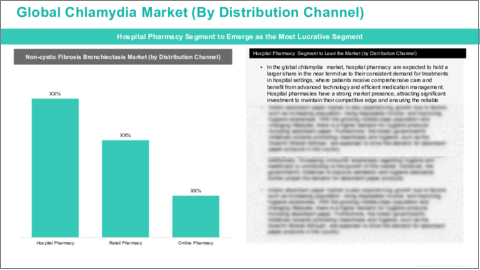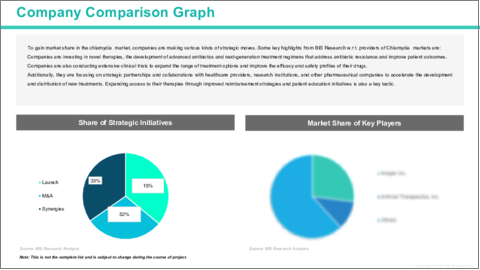|
|
市場調査レポート
商品コード
1753877
クラミジアの世界市場:流通チャネル・地域・国別の分析・予測 (2025~2035年)Chlamydia Market - A Global and Regional Analysis: Focus on Distribution Channel, Country, and Region - Analysis and Forecast, 2025-2035 |
||||||
カスタマイズ可能
|
|||||||
| クラミジアの世界市場:流通チャネル・地域・国別の分析・予測 (2025~2035年) |
|
出版日: 2025年06月23日
発行: BIS Research
ページ情報: 英文 100 Pages
納期: 1~5営業日
|
全表示
- 概要
- 図表
- 目次
クラミジア市場の主要促進要因のひとつは、世界のクラミジア感染率の上昇です。
世界保健機関 (WHO) により年間約1億2,700万人の新規感染者が報告されており、特に若年成人における発症率の増加は、より効果的な診断・治療ソリューションに対する差し迫ったニーズを生み出しています。この感染症の急増は、迅速な診断とタイムリーな治療を可能にする高感度核酸増幅検査 (NAAT) や迅速POCT (ポイントオブケア検査) などの高度な検査技術に対する需要を牽引しています。さらに、公衆衛生への取り組みやスクリーニングプログラムが拡大しており、認知度の向上や検査の奨励によって市場の成長をさらに後押ししています。医療システムがこの広く蔓延している性感染症をより適切に管理・制御しようと努めているため、これらの要因が総合的にクラミジア市場のダイナミックな拡大に寄与しています。
一方で、市場成長にもかかわらず、いくつかの課題がその潜在的可能性を妨げています。大きな障害となっているのはクラミジア感染の無症状性であり、特に女性の場合、症例の70~80%が診断されないままであるため、タイムリーな発見と治療が妨げられています。さらに、性感染症にまつわる社会的偏見やプライバシーへの懸念が、多くの人が検査や治療を受けることを躊躇させています。低・中所得国では、コストやインフラの制約から、安価で信頼性の高い診断ツールへのアクセスが依然として限られており、スクリーニングの普及が妨げられています。加えて、抗生物質耐性の脅威も重大な課題であり、抗生物質の誤用や過剰使用は治療効果を低下させる可能性があります。地域によっては規制上のハードルや断片的なヘルスケアシステムも、新しい診断技術の採用を遅らせています。これらの課題に対処することは、市場の成長を持続させ、世界の性衛生の成果を向上させる上で極めて重要です。
世界のクラミジア市場では、治療の将来を大きく左右するいくつかの重要な新興動向が見られます。中でも特に顕著なのは、ポイントオブケア検査 (POCT) 技術の急速な導入です。この技術により、患者のいる場所でほぼ即時に診断と治療判断を行うことが可能になります。この変化は、診断の遅れを減らし、患者のコンプライアンスを向上させ、資源の乏しい地域や遠隔地での検査へのアクセスを拡大する必要性によって推進されています。
さらに、クラミジア、淋病、トリコモナス症など、複数の性感染症を同時に検出できるマルチプレックス検査プラットフォームの統合が勢いを増しており、診断の効率化と臨床判断の質の向上に貢献しています。もう一つの重要な動向は、抗菌薬の適正使用と耐性モニタリングへの関心の高まりです。これは、抗生物質耐性の上昇が現在の治療レジメンに課題をもたらしていることに起因しています。さらに、遠隔検査、オンライン診療、フォローアップケアを可能にするデジタルヘルスツールや遠隔医療の利用も増加しており、より多くの人々へのアクセスを広げるとともに、患者のプライバシー向上にも寄与しています。これらすべての動向は、より患者中心で技術主導のアプローチを反映しており、治療成績の改善と世界的な感染拡大の抑制に寄与することが期待されています。
当レポートでは、世界のクラミジアの市場を調査し、主要動向、市場影響因子の分析、法規制環境、臨床試験の動向、市場規模の推移・予測、各種区分・地域/主要国別の詳細分析、競合情勢、主要企業のプロファイルなどをまとめています。
目次
エグゼクティブサマリー
第1章 世界のクラミジア市場:業界展望
- 市場動向
- 規制の枠組み
- 疫学分析
- 臨床試験分析
- 市場力学
- 影響分析
- 市場促進要因
- 市場の課題
- 市場機会
第2章 世界のクラミジア市場:流通チャネル別
- 病院薬局
- 小売薬局
- オンライン薬局
第3章 世界のクラミジア市場:地域別
- 北米
- 主な調査結果
- 市場力学
- 市場規模・予測
- 欧州
- 主な調査結果
- 市場力学
- 市場規模・予測
- アジア太平洋
- 主な調査結果
- 市場力学
- 市場規模・予測
第4章 世界のクラミジア市場:競合情勢と企業プロファイル
- 主要戦略と開発
- M&A
- 相乗効果のある活動
- 事業拡大と資金調達
- 製品の発売と承認
- その他の活動
- 企業プロファイル
- ActivBiotics Pharma LLC
- Bausch Health (Endo Pharmaceuticals)
- Allergan (Warner Chilcott)
- WCG Clinical (NAMSA)
- Hologic (Gen-Probe Incorporated)
- Evofem Inc.
- Clinical Research Management Inc. (CRMI)
- Meridian Bioscience Inc.
- Hologic, Inc.
- Pfizer Inc.
第5章 調査手法
List of Figures
- Figure: Global Chlamydia Market (by Region), $Million, 2024 and 2035
- Figure: Global Chlamydia Market Key Trends, Analysis
List of Tables
- Table: Global Chlamydia Market Dynamics, Impact Analysis
- Table: Global Chlamydia Market (by Distribution Channel), $Million, 2024-2035
- Table: Global Chlamydia Market (by Region), $Million, 2024-2035
Global Chlamydia Market, Analysis and Forecast: 2025-2035
Chlamydia is a common sexually transmitted infection (STI) caused by the bacterium Chlamydia trachomatis. It often presents without noticeable symptoms, especially in women, which can lead to undiagnosed and untreated infections. If left untreated, chlamydia can cause serious health complications such as pelvic inflammatory disease (PID), infertility, ectopic pregnancy, and increased susceptibility to other infections, including HIV. Because of its high prevalence estimated at around 127 million new cases globally each year chlamydia represents a significant public health challenge, necessitating effective screening, timely diagnosis, and treatment to control its spread.
One of the key drivers of the chlamydia market is the rising prevalence of chlamydia infections worldwide. With approximately 127 million new cases reported annually by the World Health Organization, the increasing incidence particularly among young adults has created a pressing need for more effective diagnostic and therapeutic solutions. This surge in infections drives demand for advanced testing technologies, such as highly sensitive Nucleic Acid Amplification Tests (NAATs) and rapid Point-of-Care Testing (POCT), which enable quicker diagnosis and timely treatment. Additionally, public health initiatives and screening programs are expanding, further boosting market growth by increasing awareness and encouraging testing. Collectively, these factors contribute to the dynamic expansion of the chlamydia market as healthcare systems strive to better manage and control this widespread sexually transmitted infection.
Despite the growth of the chlamydia market, several challenges continue to impede its full potential. A major obstacle is the asymptomatic nature of chlamydia infections, with up to 70-80% of cases going undiagnosed, especially among women, which hinders timely detection and treatment. Additionally, social stigma and privacy concerns around sexually transmitted infections discourage many individuals from seeking testing and care. Access to affordable and reliable diagnostic tools remains limited in low- and middle-income countries due to cost and infrastructure constraints, restricting widespread screening efforts. Furthermore, the looming threat of antibiotic resistance poses a significant challenge, as misuse or overuse of antibiotics can reduce treatment effectiveness. Regulatory hurdles and fragmented healthcare systems in some regions also delay the adoption of new diagnostic technologies. Addressing these challenges is critical to sustaining market growth and improving global sexual health outcomes.
The global chlamydia market is highly competitive, characterized by the presence of several key players driving innovation in diagnostics and therapeutics. Companies such as ActivBiotics Pharma LLC, Bausch Health (Endo Pharmaceuticals), and Allergan (Warner Chilcott) are notable for their extensive product portfolios targeting chlamydia treatment and management. Diagnostic leaders like Hologic (Gen-Probe Incorporated) and Meridian Bioscience Inc. focus on advancing rapid and accurate testing technologies, including nucleic acid amplification tests (NAATs) and point-of-care platforms. Additionally, Evofem Inc. and Clinical Research Management Inc. (CRMI) contribute through clinical research and novel therapeutic approaches. Pharmaceutical giants Pfizer Inc. and Merck KGaA further bolster the market with a broad range of antibiotics and treatment options. The competitive intensity among these players is fuelled by continuous investment in research and development, strategic collaborations, and efforts to expand access to innovative diagnostics and therapeutics globally. This dynamic ecosystem promotes rapid advancements aimed at improving detection, treatment efficacy, and patient outcomes in the fight against chlamydia infections.
Market Segmentation:
Segmentation 1: by Distribution Channel
- Hospital Pharmacy
- Retail Pharmacy
- Online Pharmacy
Segmentation 2: by Region
- North America
- Europe
- Asia-Pacific
The global chlamydia market is experiencing several key emerging trends that are significantly shaping the future of treatment. One of the most prominent trends is the rapid adoption of Point-of-Care Testing (POCT) technologies, which enable near-instantaneous diagnosis and treatment decisions at the patient's location. This shift is driven by the need to reduce diagnostic delays, improve patient compliance, and expand access to testing in resource-limited and remote settings.
Additionally, integration of multiplex testing platforms that simultaneously detect multiple sexually transmitted infections including chlamydia, gonorrhea, and trichomoniasis is gaining momentum, streamlining diagnosis and enhancing clinical decision-making. Another critical trend is the growing emphasis on antimicrobial stewardship and resistance monitoring, as rising antibiotic resistance poses challenges to current treatment regimens. Furthermore, the market is witnessing increased use of digital health tools and telemedicine, which facilitate remote testing, consultation, and follow-up care, broadening outreach and improving privacy for patients. Together, these trends reflect a more patient-centric, technology-driven approach to chlamydia management that promises to improve outcomes and curb transmission rates worldwide.
Table of Contents
Executive Summary
Scope and Definition
Market/Product Definition
Inclusion and Exclusion
Key Questions Answered
Analysis and Forecast Note
1. Global Chlamydia Market: Industry Outlook
- 1.1 Introduction
- 1.2 Market Trends
- 1.3 Regulatory Framework
- 1.4 Epidemiology Analysis
- 1.5 Clinical Trial Analysis
- 1.6 Market Dynamics
- 1.6.1 Impact Analysis
- 1.6.2 Market Drivers
- 1.6.3 Market Challenges
- 1.6.4 Market Opportunities
2. Global Chlamydia Market (Distribution Channel), ($Million), 2023-2035
- 2.1 Hospital Pharmacy
- 2.2 Retail Pharmacy
- 2.3 Online Pharmacy
3. Global Chlamydia Market (Region), ($Million), 2023-2035
- 3.1 North America
- 3.1.1 Key Findings
- 3.1.2 Market Dynamics
- 3.1.3 Market Sizing and Forecast
- 3.1.3.1 North America Chlamydia Market, by Country
- 3.1.3.1.1 U.S.
- 3.1.3.1 North America Chlamydia Market, by Country
- 3.2 Europe
- 3.2.1 Key Findings
- 3.2.2 Market Dynamics
- 3.2.3 Market Sizing and Forecast
- 3.2.3.1 Europe Chlamydia Market, by Country
- 3.2.3.1.1 Germany
- 3.2.3.1.2 U.K.
- 3.2.3.1.3 France
- 3.2.3.1.4 Italy
- 3.2.3.1 Europe Chlamydia Market, by Country
- 3.3 Asia Pacific
- 3.3.1 Key Findings
- 3.3.2 Market Dynamics
- 3.3.3 Market Sizing and Forecast
- 3.3.3.1 Asia Pacific Chlamydia Market, by Country
- 3.3.3.1.1 China
- 3.3.3.1.2 Japan
- 3.3.3.1 Asia Pacific Chlamydia Market, by Country
4. Global Chlamydia Market: Competitive Landscape and Company Profiles
- 4.1 Key Strategies and Development
- 4.1.1 Mergers and Acquisitions
- 4.1.2 Synergistic Activities
- 4.1.3 Business Expansions and Funding
- 4.1.4 Product Launches and Approvals
- 4.1.5 Other Activities
- 4.2 Company Profiles
- 4.2.1 ActivBiotics Pharma LLC
- 4.2.1.1 Overview
- 4.2.1.2 Top Products / Product Portfolio
- 4.2.1.3 Top Competitors
- 4.2.1.4 Target Customers/End-Users
- 4.2.1.5 Key Personnel
- 4.2.1.6 Analyst View
- 4.2.2 Bausch Health (Endo Pharmaceuticals)
- 4.2.2.1 Overview
- 4.2.2.2 Top Products / Product Portfolio
- 4.2.2.3 Top Competitors
- 4.2.2.4 Target Customers/End-Users
- 4.2.2.5 Key Personnel
- 4.2.2.6 Analyst View
- 4.2.3 Allergan (Warner Chilcott)
- 4.2.3.1 Overview
- 4.2.3.2 Top Products / Product Portfolio
- 4.2.3.3 Top Competitors
- 4.2.3.4 Target Customers/End-Users
- 4.2.3.5 Key Personnel
- 4.2.3.6 Analyst View
- 4.2.4 WCG Clinical (NAMSA)
- 4.2.4.1 Overview
- 4.2.4.2 Top Products / Product Portfolio
- 4.2.4.3 Top Competitors
- 4.2.4.4 Target Customers/End-Users
- 4.2.4.5 Key Personnel
- 4.2.4.6 Analyst View
- 4.2.5 Hologic (Gen-Probe Incorporated)
- 4.2.5.1 Overview
- 4.2.5.2 Top Products / Product Portfolio
- 4.2.5.3 Top Competitors
- 4.2.5.4 Target Customers/End-Users
- 4.2.5.5 Key Personnel
- 4.2.5.6 Analyst View
- 4.2.6 Evofem Inc.
- 4.2.6.1 Overview
- 4.2.6.2 Top Products / Product Portfolio
- 4.2.6.3 Top Competitors
- 4.2.6.4 Target Customers/End-Users
- 4.2.6.5 Key Personnel
- 4.2.6.6 Analyst View
- 4.2.7 Clinical Research Management Inc. (CRMI)
- 4.2.7.1 Overview
- 4.2.7.2 Top Products / Product Portfolio
- 4.2.7.3 Top Competitors
- 4.2.7.4 Target Customers/End-Users
- 4.2.7.5 Key Personnel
- 4.2.7.6 Analyst View
- 4.2.8 Meridian Bioscience Inc.
- 4.2.8.1 Overview
- 4.2.8.2 Top Products / Product Portfolio
- 4.2.8.3 Top Competitors
- 4.2.8.4 Target Customers/End-Users
- 4.2.8.5 Key Personnel
- 4.2.8.6 Analyst View
- 4.2.9 Hologic, Inc.
- 4.2.9.1 Overview
- 4.2.9.2 Top Products / Product Portfolio
- 4.2.9.3 Top Competitors
- 4.2.9.4 Target Customers/End-Users
- 4.2.9.5 Key Personnel
- 4.2.9.6 Analyst View
- 4.2.10 Pfizer Inc.
- 4.2.10.1 Overview
- 4.2.10.2 Top Products / Product Portfolio
- 4.2.10.3 Top Competitors
- 4.2.10.4 Target Customers/End-Users
- 4.2.10.5 Key Personnel
- 4.2.10.6 Analyst View
- 4.2.1 ActivBiotics Pharma LLC






